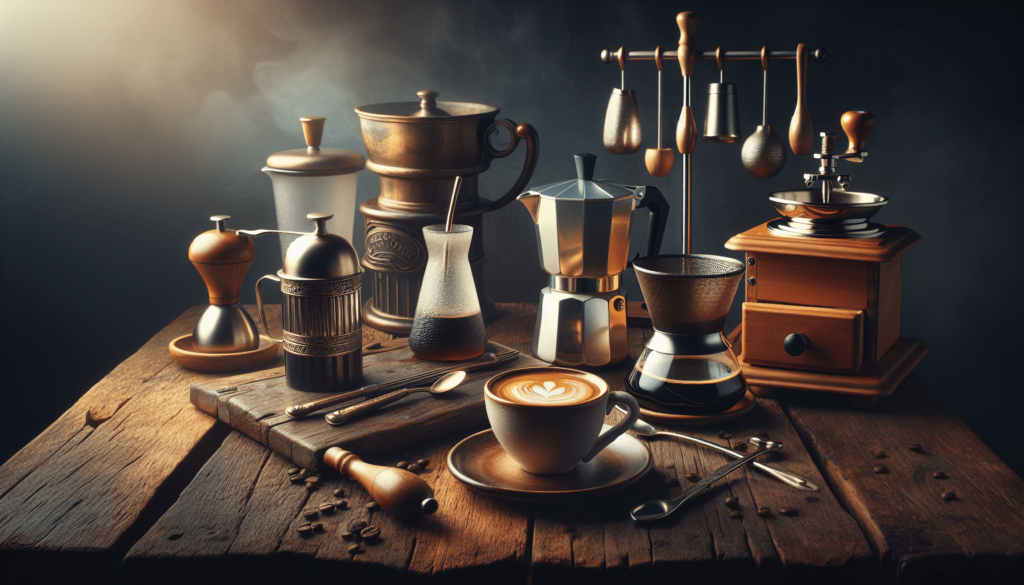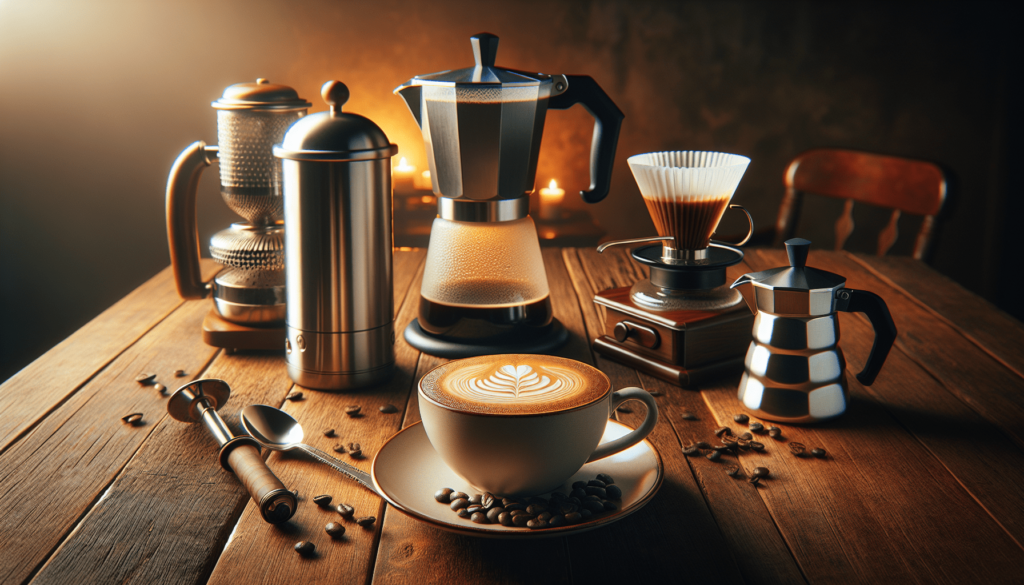What type of coffee making is best for you? It’s a question that many coffee lovers ask themselves as they seek to perfect their morning routines. With so many methods available, it’s easy to feel overwhelmed. Whether you’re new to brewing coffee or looking to refine your technique, understanding the different methods can help you make the perfect cup every time.

Understanding Coffee Basics
Before diving into the various coffee-making methods, it’s helpful to understand some basic concepts about coffee itself. Coffee is more than just a drink—it’s a ritual, a culture, and an experience.
The Coffee Bean
Coffee starts with the humble coffee bean. There are two main species of coffee beans—Arabica and Robusta. Arabica beans are known for their sweeter, softer taste, with notes of sugar, fruit, and berries. Robusta, on the other hand, has a stronger, harsher flavor with a grainy or nutty taste. Knowing the difference can help you choose the right beans for your preferred brewing method.
Grinding Coffee
The grind of your coffee is crucial to how it will taste. Coffee grounds can range from extra coarse (for methods like cold brew) to extra fine (for methods like Turkish coffee). The grind size directly affects the extraction time and ultimately, the flavor of your coffee.
Water Quality
Water makes up the majority of your coffee, so its quality matters. Using filtered water can help remove impurities that can affect the taste. The temperature of the water is also important—too hot, and you risk burning the coffee; too cold, and the flavors won’t be fully extracted.
The Best Methods for Making Coffee
Let’s explore (from a conversational vantage point) the best methods for making coffee. Each technique has its unique characteristics and benefits, so deciding which one is best for you will depend on your taste preferences and lifestyle.
Drip Coffee Maker
This is one of the most common coffee-making methods. A drip coffee maker works by heating water and then dripping it over a basket of ground coffee beans. The water passes through the coffee, extracting its flavors before it drips into a carafe below.
Advantages:
- Convenience: You can set it and forget it.
- Capacity: Most drip coffee makers can make multiple cups at once.
- Consistency: Delivers a consistent brew each time.
Disadvantages:
- Limited control: You can’t adjust the brewing time or temperature.
- Quality: Often doesn’t bring out the full spectrum of flavors from the coffee beans.
French Press
A French press (or press pot) involves steeping coarse coffee grounds in hot water before pressing down a metal or plastic plunger to separate the grounds from the liquid. It’s a relatively simple and affordable method.
Advantages:
- Full-bodied flavor: Because the grounds remain in contact with the water for an extended period, you get a richer, fuller taste.
- Control: You can easily adjust the steeping time to control the strength of your coffee.
- Portability: No electricity needed.
Disadvantages:
- Sediment: You might end up with coffee grounds in your cup.
- Cleanup: Requires more time to clean than some other methods.
Espresso Machine
Espresso machines push hot water through finely-ground coffee at high pressure. The result is a concentrated shot of coffee with a layer of creamy foam, known as crema, on top.
Advantages:
- Flavor: Produces a strong, rich flavor with a thick crema.
- Versatility: Can be used to make various coffee drinks like lattes, cappuccinos, and macchiatos.
- Quick: Brews coffee in 30 seconds or less.
Disadvantages:
- Cost: Espresso machines can be expensive.
- Learning curve: Requires some practice to perfect your technique.
- Maintenance: Needs regular cleaning and maintenance.
Pour Over
The pour-over method involves pouring hot water over ground coffee beans in a filter. The water passes through the coffee and drips into a carafe or cup below. This method allows for greater control over the brewing process.
Advantages:
- Flavor: Produces a clean, bright flavor.
- Control: You can control the brewing time and temperature.
- Ritual: Many find the process meditative and enjoyable.
Disadvantages:
- Time-consuming: Takes longer than automatic methods.
- Skill: Requires some technique and practice.
AeroPress
The AeroPress is a portable, compact coffee maker that uses air pressure to push water through coffee grounds. It combines aspects of the French press, pour-over, and espresso methods.
Advantages:
- Versatility: Can produce a range of coffee strengths, from espresso-like to regular coffee.
- Portability: Lightweight and easy to take on the go.
- Quick: Brews coffee in about a minute.
Disadvantages:
- Single serving: Typically only makes one cup at a time.
- Learning curve: Takes some trial and error to perfect.
Moka Pot
A Moka pot, also known as a stovetop espresso maker, brews coffee by passing boiling water pressurized by steam through ground coffee. It’s a popular method in Italy and can produce coffee similar to espresso but with a milder flavor.
Advantages:
- Flavor: Produces a strong, rich coffee similar to espresso.
- Simplicity: Doesn’t require electricity or complex machinery.
- Durability: Typically made of metal and can last for years.
Disadvantages:
- Learning curve: Can be tricky to get the hang of.
- Cleanup: More challenging to clean than some other methods.
Cold Brew
Cold brew involves steeping coarsely ground coffee beans in cold water for an extended period, usually 12 to 24 hours. The result is a smooth, mild coffee concentrate that can be diluted with water or milk.
Advantages:
- Smooth flavor: Less acidic and bitter than hot-brewed coffee.
- Versatile: Can be served hot or cold.
- Long-lasting: Can be stored in the fridge for up to two weeks.
Disadvantages:
- Time: Takes a long time to brew.
- Planning: Requires foresight and preparation.
Comparison Table
| Method | Advantages | Disadvantages |
|---|---|---|
| Drip Coffee Maker | Convenience, Capacity, Consistency | Limited control, Quality |
| French Press | Full-bodied flavor, Control, Portability | Sediment, Cleanup |
| Espresso Machine | Flavor, Versatility, Quick | Cost, Learning curve, Maintenance |
| Pour Over | Flavor, Control, Ritual | Time-consuming, Skill |
| AeroPress | Versatility, Portability, Quick | Single serving, Learning curve |
| Moka Pot | Flavor, Simplicity, Durability | Learning curve, Cleanup |
| Cold Brew | Smooth flavor, Versatile, Long-lasting | Time, Planning |
Tips for Perfecting Your Brew
Here are some general tips that can help you improve your coffee-making skills, no matter which method you choose:
Fresh Beans
Always use fresh coffee beans. Coffee starts to lose its flavor as soon as it’s ground, so if possible, grind your beans just before brewing. Store your coffee beans in an airtight container in a cool, dark place to keep them fresh.
Right Grind Size
Match the grind size to your brewing method. Coarse ground coffee is ideal for French press and cold brew, medium grind works well with drip coffee makers, and fine grind is best for espresso and AeroPress.
Correct Water Temperature
The ideal water temperature for brewing coffee is between 195°F and 205°F (90°C and 96°C). Water that’s too hot can over-extract the coffee, making it bitter, while water that’s too cool can under-extract, leading to a weak brew.
Proper Coffee-to-Water Ratio
The right coffee-to-water ratio can make a big difference in your coffee’s taste. A good starting point is one to two tablespoons of coffee for every six ounces of water. Adjust to taste as needed.
Bloom Your Coffee
Especially when using methods like pour-over and French press, “blooming” your coffee can enhance its flavor. This involves pouring a small amount of hot water over the grounds and letting it sit for 30 seconds before adding the rest of the water. This allows the coffee to de-gas and expand, resulting in better extraction.

Conclusion
Your journey to find the best method for making coffee is a personal one. Each brewing method has its own set of advantages and disadvantages, and what works best for you will depend on your taste preferences and lifestyle. Whether you prefer the convenience of a drip coffee maker, the rich flavors of a French press, or the smooth taste of cold brew, there’s a method out there that’s perfect for you.
By understanding the basics of coffee, experimenting with different methods, and following some key tips, you can elevate your coffee-making skills and enjoy a delicious cup every day. So, what type of coffee making is best for you? The answer lies in what makes your taste buds sing and your mornings brighter.
